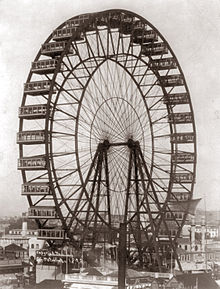Ferris Wheel (1893)
Ferris kept on with the wheel ideas and proposed a bigger and taller tower, to stand as its own centerpiece at the World's Columbian Exposition.The completed wheel rotated on a 71-ton, 45.5 foot (13.9 meter) long axle that was at that time the world's largest hollow forging.Upon first seeing the wheel which towered over everything in its vicinity, Julian Hawthorne, son of the author Nathaniel, was amazed that anything of such a size "continues to keep itself erect ... it has no visible means of support – none that appear adequate.The workmen however, climbed the structure and settled themselves on the spokes to the accompaniment of cheers from an audience of fair employees who had gathered to watch the momentous event.[1] The Ferris Wheel took 20 minutes to make two revolutions, the first involving six stops to allow passengers to exit and enter and the second a nine-minute non-stop rotation, for which the ticket holder paid 50 cents (equivalent to $16.96 in 2023).In 1896, the Lumiere Brothers, inventors of cinema, shot film (catalogue number 338[14][15]) of the intersection of Wrightwood and Clark which included the Ferris wheel.The wheel operated at Clark St. from October 1895 until 1903, when it was purchased at auction by the Chicago House Wrecking Company (CHWC) for $8,150[17] (equivalent to $276,380 in 2023).After the 1904 World's Fair closed on December 1, 1904, no purchasers were found who would pay for the relocation of the great Ferris Wheel, despite many efforts."[18] In 2007, a magnetic survey using a cesium magnetometer[19] indicated that a long, steel or iron object (presumed to be the axle) was buried under a major street roughly 200 feet (61 m) from where the wheel was demolished.





ChicagoUnited StatesGeorge Washington Gale Ferris Jr.MidwayWorld's Columbian ExpositionChicago, IllinoisFerris wheels1889 Paris ExpositionEiffel TowerLincoln Park, Chicago1904 World's FairSt. Louis, MissouriGustave EiffelDaniel BurnhamRensselaer Polytechnic InstitutePittsburgh, PennsylvaniaJackson ParkBethlehem Iron CompanyNathanielMidway PlaisanceWilliam D. BoyceLumiere BrothersSt. LouismagnetometerNavy PierFerris wheelRobert LawsonThe Great WheelMeet Me in St. LouisMy Chemical RomanceI Brought You My Bullets, You Brought Me Your LoveInternet ArchiveWorld Digital LibraryClinton, IllinoisWorld's tallest Ferris wheelGreat WheelWorld's tallest Ferris wheelsRoda RicoRio StarHigh RollerThe Wheel at ICON Park OrlandoBailang River Bridge Ferris WheelBay GloryChangsha Ferris WheelHarbin Ferris WheelStar of NanchangSuzhou Ferris WheelTianjin EyeZhengzhou Ferris WheelAin DubaiCosmo Clock 21DaikanranshaDiamond and Flower Ferris WheelIgosu 108Redhorse Osaka WheelSky Dream FukuokaTechnocosmos / TechnostarTempozan Ferris WheelSingapore FlyerGrande Roue de ParisEurowheelLondon EyeMelbourne StarList of Ferris wheelsNiagara SkyWheelCapital WheelColossusMyrtle Beach SkyWheelSeattle Great WheelSkyStar WheelTexas StarUniroyal Giant TireHong Kong Observation WheelAmuranWiener RiesenradBaku Ferris WheelSun of MoscowBussink Design R80XLRoue de ParisSteiger Ferris WheelWheel of BrisbaneDelhi EyeEye on Malaysia (Kuala Lumpur and Malacca)Belfast WheelBrighton WheelRoyal Windsor WheelWheel of BirminghamWheel of DublinWheel of LiverpoolWheel of ManchesterWheel of SheffieldYorkshire WheelPixar Pal-A-RoundWonder WheelGiant Wheel (Hersheypark)Sky WhirlNew York WheelSkyvueBeijing Great WheelGreat Berlin WheelKolkata EyeGreat Orlando WheelAllan Herschell CompanyChance MorganGreat City Attractions (previously World Tourist Attractions)Great Wheel Corporation (merged with World Tourist Attractions in 2009)IntaminMondialRonald Bussink (Nauta Bussink / Bussink Landmarks / Bussink Design)Sanoyas Rides CorporationVekoma (Dutch Wheels)Waagner-BiroWheels EntertainmentsThe Great Wheel (novel)The London Eye Mystery (novel)Amusement ridesAli BabaBalloon RaceBayern KurveBooster (Fabbri)Booster (HUSS)BreakdanceBulgy the WhaleBumper boatsBumper carsBungee trampoline